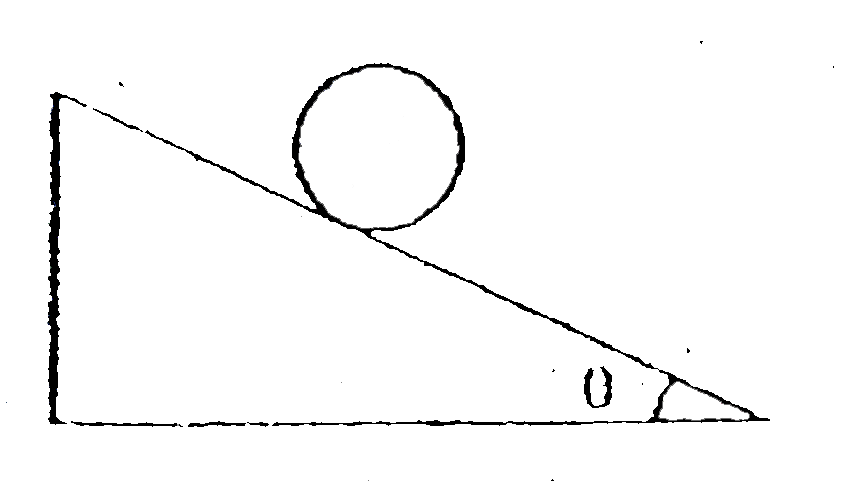Calculate the velocity with which a solid cylinder rolls down an inclined plane of height 10m with slipping (take g=10m/s2)
To calculate the velocity with which a solid cylinder rolls down an inclined plane of height h=10m without slipping, we can use the principle of conservation of energy. Here's the step-by-step solution:
Step 1: Understand the Energy Conservation Principle
The potential energy (PE) lost by the cylinder as it rolls down the incline will be converted into kinetic energy (KE). The total kinetic energy will consist of both translational and rotational kinetic energy.
Step 2: Write the Potential Energy
The potential energy at the height h is given by:
PE=mgh
where m is the mass of the cylinder, g=10m/s2 (acceleration due to gravity), and h=10m.
Step 3: Write the Kinetic Energy
The total kinetic energy when the cylinder rolls down is the sum of translational kinetic energy and rotational kinetic energy:
KEtotal=KEtranslational+KErotational
KEtranslational=12mv2
KErotational=12Iω2
where v is the linear velocity, I is the moment of inertia of the cylinder, and ω is the angular velocity.
Step 4: Moment of Inertia and Relationship Between Linear and Angular Velocity
For a solid cylinder, the moment of inertia I is given by:
I=12mR2
where R is the radius of the cylinder. The relationship between linear velocity v and angular velocity ω is:
ω=vR
Step 5: Substitute the Values into Kinetic Energy
Substituting I and ω into the kinetic energy equation:
KErotational=12(12mR2)(vR)2=14mv2
Thus, the total kinetic energy becomes:
KEtotal=12mv2+14mv2=34mv2
Step 6: Set Potential Energy Equal to Kinetic Energy
According to the conservation of energy:
mgh=34mv2
The mass m cancels out:
gh=34v2
Step 7: Solve for v2
Rearranging the equation gives:
v2=4gh3
Step 8: Substitute the Values
Substituting g=10m/s2 and h=10m:
v2=4×10×103=4003
Step 9: Calculate v
Taking the square root:
v=√4003=20√3m/s
Final Answer
The velocity with which the solid cylinder rolls down the inclined plane is:
v≈11.55m/s
---
The potential energy (PE) lost by the cylinder as it rolls down the incline will be converted into kinetic energy (KE). The total kinetic energy will consist of both translational and rotational kinetic energy.
The potential energy at the height h is given by:
PE=mgh
where m is the mass of the cylinder, g=10m/s2 (acceleration due to gravity), and h=10m.
The total kinetic energy when the cylinder rolls down is the sum of translational kinetic energy and rotational kinetic energy:
KEtotal=KEtranslational+KErotational
KEtranslational=12mv2
KErotational=12Iω2
where v is the linear velocity, I is the moment of inertia of the cylinder, and ω is the angular velocity.
For a solid cylinder, the moment of inertia I is given by:
I=12mR2
where R is the radius of the cylinder. The relationship between linear velocity v and angular velocity ω is:
ω=vR
Substituting I and ω into the kinetic energy equation:
KErotational=12(12mR2)(vR)2=14mv2
Thus, the total kinetic energy becomes:
KEtotal=12mv2+14mv2=34mv2
According to the conservation of energy:
mgh=34mv2
The mass m cancels out:
gh=34v2
Rearranging the equation gives:
v2=4gh3
Substituting g=10m/s2 and h=10m:
v2=4×10×103=4003
Taking the square root:
v=√4003=20√3m/s
The velocity with which the solid cylinder rolls down the inclined plane is:
v≈11.55m/s
Topper's Solved these Questions
- SYSTEM OF PARTICLES AND ROTATIONAL MOTIONBOOK - AAKASH INSTITUTE ENGLISHCHAPTER - SYSTEM OF PARTICLES AND ROTATIONAL MOTIONEXERCISE - Assignment (Section - J) Aakash Challengers Questions
13 Videos
- SEMICONDUCTOR ELECTRONICS: MATERIALS, DEVICES AND SIMPLE CIRCUITSBOOK - AAKASH INSTITUTE ENGLISHCHAPTER - SEMICONDUCTOR ELECTRONICS: MATERIALS, DEVICES AND SIMPLE CIRCUITSEXERCISE - Assignment (Section-D (Assertion and reason))
5 Videos
- TEST 1BOOK - AAKASH INSTITUTE ENGLISHCHAPTER - TEST 1EXERCISE - EXERCISE
21 Videos
Similar Questions
If a solid cylinder rolls down an inclined plane, then its:
View SolutionA solid cylinder is rolling down a rough inclined plane of inclination θ. Then
View SolutionThe speed of a uniform solid cylinder after rolling down an inclined plane of vertical height H, from rest without sliding is :-
View SolutionA cylinder rolls down an inclined plane of inclination 30∘, the acceleration of cylinder is
View SolutionA solid cylinder is rolling down the inclined plane without slipping. Which of the following is correct?

View SolutionA ring starts to roll down the inclined plane of height h without slipping . The velocity when it reaches the ground is
View SolutionA cylinder rolls down two different inclined planes of the same height but of different inclinations
View SolutionA solid cylinder of mass M and radius R rolls down an inclined plane of height h without slipping. The speed of its centre when it reaches the bottom is.
View SolutionThe speed of a homogeneous solid sphere after rolling down an inclined plane of vertical height h from rest without slipping will be.
View SolutionThe speed of a homogeneous solid sphere after rolling down an inclined plane of vertical height h from rest without slipping will be.
View Solution
